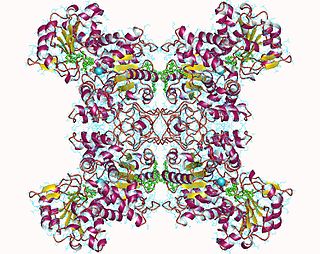| phenylglyoxylate dehydrogenase (acylating) | |||||||||
|---|---|---|---|---|---|---|---|---|---|
| Identifiers | |||||||||
| EC no. | 1.2.1.58 | ||||||||
| CAS no. | 205510-78-7 | ||||||||
| Databases | |||||||||
| IntEnz | IntEnz view | ||||||||
| BRENDA | BRENDA entry | ||||||||
| ExPASy | NiceZyme view | ||||||||
| KEGG | KEGG entry | ||||||||
| MetaCyc | metabolic pathway | ||||||||
| PRIAM | profile | ||||||||
| PDB structures | RCSB PDB PDBe PDBsum | ||||||||
| Gene Ontology | AmiGO / QuickGO | ||||||||
| |||||||||
In enzymology, a phenylglyoxylate dehydrogenase (acylating; EC 1.2.1.58) is an enzyme that catalyzes the chemical reaction
- phenylglyoxylate + NAD+ + CoA-SH benzoyl-S-CoA + CO2 + NADH
The three substrates of this enzyme are phenylglyoxylate, NAD+, and CoA-SH, whereas its 3 products are benzoyl-S-CoA, CO2, and NADH.
This enzyme belongs to the family of oxidoreductases, specifically those acting on the aldehyde or oxo group of donor with NAD+ or NADP+ as acceptor. The systematic name of this enzyme class is phenylglyoxylate:NAD+ oxidoreductase. It has 3 cofactors: FAD, Thiamin diphosphate, and Iron-sulfur.





